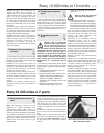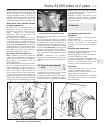
10 With the engine idling, turn the idle speed
screw on the interconnecting linkage as
necessary until the engine speed is 1000 rpm.
11 Note the reading on the vacuum gage,
then transfer the gauge pipe to the vacuum
pipe stub on the right-hand carburettor. If the
reading is not as previously recorded, turn the
synchronising screw on the linkage as
necessary until an identical reading is shown
on the gauge.
12 Blip the throttle once or twice and check
that both vacuum readings are as previously
indicated.
13 Reset the idle speed by means of the idle
speed screw to obtain the specified idling
speed.
14 If a vacuum gauge is not available a
carburettor synchronising tool available at
most motor stores can be used instead.
These instruments are basically airflow meters
and should show identical readings when
moved from one carburettor venturi to the
other. Adjust the airflow through the
carburettor, by means of the synchronising
screw, until both carburettors show the same
reading on the tool. When correct, reset the
idling speed by means of the idle speed screw
to obtain the specified speed. Note that if one
of these instruments is being used, it will not
be necessary to disconnect the carburettor
vacuum pipes.
15 If the idle mixture CO content is not to be
adjusted, switch off the engine, disconnect
the instruments and refit all disturbed
components.
Idle mixture CO level adjustment
16 The idle mixture (exhaust gas CO level) is
set at the factory, and should require no
further adjustment. If, due to a change in
engine characteristics (carbon build-up, bore
wear etc) or after a major carburettor
overhaul, the mixture setting is lost, it can be
reset. Note, however, that an exhaust gas
analyser (CO meter) will be required to check
the mixture, in order to set it with the
necessary standard of accuracy; if this is not
available, the car must be taken to a Peugeot
dealer for the work to be carried out.
17 If an exhaust gas analyser is available,
follow its manufacturer’s instructions to check
the exhaust gas CO level. If adjustment is
required, it is made by turning the mixture
adjustment screw as necessary. As with the
idle speed screw, the mixture adjusting screw
is situated in various locations according to
carburettor type (see illustrations).The screw
may also be covered with a tamperproof plug
to prevent unnecessary adjustment. If so, use
a sharp instrument to hook out the plug.
18 Using a suitable flat-bladed screwdriver,
turn the mixture adjustment screw (in very
small increments) until the CO level is correct.
Turning the screw in (clockwise) weakens the
mixture and reduces the CO level, turning it
out will richen the mixture and increase the
CO level. On twin carburettor installations turn
both mixture adjustment screws by equal
amounts when making the adjustments.
19 When adjustments are complete,
disconnect any test equipment, and fit a new
tamperproof plug to the mixture adjustment
screw. Recheck the idle speed and, if
necessary, readjust.
Single-point fuel injection
models
20 Experienced home mechanics with a
considerable amount of skill and equipment
(including a good-quality tachometer and a
good-quality, carefully-calibrated exhaust gas
analyser) may be able to check the exhaust
CO level and the idle speed. However, if these
are found to be in need of adjustment, the car
must be taken to a suitably-equipped
1•18 Every 24 000 miles or 2 years
28.17a Typical idle mixture adjusting
screw location (B) on the
Solex PBISA carburettors
A and B Vacuum gauge pipe connections
28.17b Idle mixture adjusting screw
location (2) on the
Weber IBSH carburettors
28.17c Idle mixture adjusting screw
location (2) on the
Weber 36 TLC carburettors
28.9b Adjustment points on the Weber twin carburettor installation
1 Mixture screw
2 Mixture screw
3 Idle speed screw
4 Vacuum pipe
5 Vacuum pipe
6 Synchronising screw


















